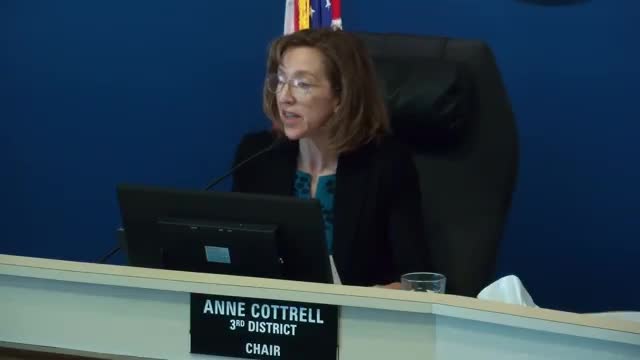Napa County Board discusses $10M escape assessment from local winery
May 22, 2025 | Napa County, California
This article was created by AI summarizing key points discussed. AI makes mistakes, so for full details and context, please refer to the video of the full meeting. Please report any errors so we can fix them. Report an error »

During the Napa County Board of Supervisors meeting on May 20, 2025, significant discussions centered around the county's ongoing efforts to enhance collaboration with the local wine industry and address substantial financial assessments related to business properties.
One of the key highlights was the acknowledgment of Dave Hsu for his service to the county, reflecting the board's commitment to recognizing contributions from its members. Following this, the board discussed the potential for a follow-up session with Napa Valley Vintners, aimed at educating new planning commissioners about the wine industry's challenges and contributions to the local economy. This initiative underscores the board's recognition of the wine sector's vital role in Napa County and its desire to foster better understanding and cooperation between industry stakeholders and local governance.
A significant portion of the meeting was dedicated to a discussion led by John Tudor, the county assessor, regarding an escape assessment exceeding $10 million. Tudor explained that this assessment arose from a reporting issue during the transition from paper to electronic filing by a large winery. The oversight resulted in the misreporting of valuable equipment, which is crucial for the winery's operations. Tudor emphasized that this assessment marks the beginning of a process, not the conclusion, as it opens avenues for communication and potential appeals from the property owner.
The board members expressed concerns about the implications of such large assessments, particularly regarding the fairness and accuracy of property evaluations. Tudor reassured them that the audit process is designed to ensure equity, noting that many audits often reveal overpayments by property owners rather than underpayments. He highlighted the importance of transparency in the assessment process, explaining that the board's approval is necessary for any assessment over $10 million, while smaller assessments are managed by staff.
The discussion also touched on the penalties associated with late filings, which can add complexity to the assessment process. Tudor clarified that penalties are applied only in cases of failure to file, not based on the accuracy of reported values. This distinction is crucial for understanding the financial implications for both the county and the property owners involved.
In conclusion, the meeting underscored the Napa County Board of Supervisors' commitment to fostering collaboration with local industries while navigating complex financial assessments. The anticipated follow-up with Napa Valley Vintners and the ongoing dialogue regarding property assessments reflect the board's proactive approach to addressing community needs and ensuring fair governance. As the board moves forward, the outcomes of these discussions will likely shape future interactions between the county and its vital agricultural sectors.
One of the key highlights was the acknowledgment of Dave Hsu for his service to the county, reflecting the board's commitment to recognizing contributions from its members. Following this, the board discussed the potential for a follow-up session with Napa Valley Vintners, aimed at educating new planning commissioners about the wine industry's challenges and contributions to the local economy. This initiative underscores the board's recognition of the wine sector's vital role in Napa County and its desire to foster better understanding and cooperation between industry stakeholders and local governance.
A significant portion of the meeting was dedicated to a discussion led by John Tudor, the county assessor, regarding an escape assessment exceeding $10 million. Tudor explained that this assessment arose from a reporting issue during the transition from paper to electronic filing by a large winery. The oversight resulted in the misreporting of valuable equipment, which is crucial for the winery's operations. Tudor emphasized that this assessment marks the beginning of a process, not the conclusion, as it opens avenues for communication and potential appeals from the property owner.
The board members expressed concerns about the implications of such large assessments, particularly regarding the fairness and accuracy of property evaluations. Tudor reassured them that the audit process is designed to ensure equity, noting that many audits often reveal overpayments by property owners rather than underpayments. He highlighted the importance of transparency in the assessment process, explaining that the board's approval is necessary for any assessment over $10 million, while smaller assessments are managed by staff.
The discussion also touched on the penalties associated with late filings, which can add complexity to the assessment process. Tudor clarified that penalties are applied only in cases of failure to file, not based on the accuracy of reported values. This distinction is crucial for understanding the financial implications for both the county and the property owners involved.
In conclusion, the meeting underscored the Napa County Board of Supervisors' commitment to fostering collaboration with local industries while navigating complex financial assessments. The anticipated follow-up with Napa Valley Vintners and the ongoing dialogue regarding property assessments reflect the board's proactive approach to addressing community needs and ensuring fair governance. As the board moves forward, the outcomes of these discussions will likely shape future interactions between the county and its vital agricultural sectors.
View full meeting
This article is based on a recent meeting—watch the full video and explore the complete transcript for deeper insights into the discussion.
View full meeting
